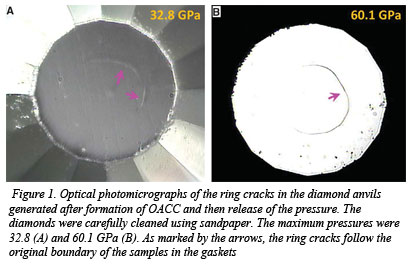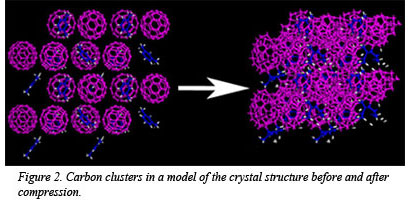 A team of CDAC scientist led by Lin Wang (HPSynC) and including Wenge Yang (HPSynC), Zhenxian Liu (U2A), Stanislav Sinogeikin (HPCAT), Yue Meng (HPCAT), and CDAC partner Wendy Mao (Stanford), along with collaborators from Jilin University, the University of Nebraska, and Argonne National Laboratory, has observed a new form of very hard carbon clusters, which are unusual in their mix of crystalline and disordered structure. The material is capable of indenting diamond. This finding has potential applications for a range of mechanical, electronic, and electrochemical uses. Carbon is the fourth-most-abundant element in the universe and takes on a wide variety of forms—the honeycomb-like graphene, the pencil “lead” graphite, diamond, cylindrically structured nanotubes, and hollow spheres called fullerenes. Some forms of carbon are crystalline, meaning that the structure is organized in repeating atomic units. Other forms are amorphous, meaning that the structure lacks the long-range order of crystals. Hybrid products that combine both crystalline and amorphous elements had not previously been observed, although scientists believed they could be created.
A team of CDAC scientist led by Lin Wang (HPSynC) and including Wenge Yang (HPSynC), Zhenxian Liu (U2A), Stanislav Sinogeikin (HPCAT), Yue Meng (HPCAT), and CDAC partner Wendy Mao (Stanford), along with collaborators from Jilin University, the University of Nebraska, and Argonne National Laboratory, has observed a new form of very hard carbon clusters, which are unusual in their mix of crystalline and disordered structure. The material is capable of indenting diamond. This finding has potential applications for a range of mechanical, electronic, and electrochemical uses. Carbon is the fourth-most-abundant element in the universe and takes on a wide variety of forms—the honeycomb-like graphene, the pencil “lead” graphite, diamond, cylindrically structured nanotubes, and hollow spheres called fullerenes. Some forms of carbon are crystalline, meaning that the structure is organized in repeating atomic units. Other forms are amorphous, meaning that the structure lacks the long-range order of crystals. Hybrid products that combine both crystalline and amorphous elements had not previously been observed, although scientists believed they could be created.
 The researchers started with carbon-60 cages, made of highly organized balls of carbon constructed of pentagon and hexagon rings bonded together to form a round, hollow shape. An organic xylene solvent was put into the spaces between the balls and formed a new structure. They then applied pressure to this combination of carbon cages and solvent, to see how it changed under different stresses. At relatively low pressure, the carbon-60’s cage structure remained. But as the pressure increased, the cage structures started to collapse into more amorphous carbon clusters. However, the amorphous clusters still occupy their original sites, forming a lattice structure.
The researchers started with carbon-60 cages, made of highly organized balls of carbon constructed of pentagon and hexagon rings bonded together to form a round, hollow shape. An organic xylene solvent was put into the spaces between the balls and formed a new structure. They then applied pressure to this combination of carbon cages and solvent, to see how it changed under different stresses. At relatively low pressure, the carbon-60’s cage structure remained. But as the pressure increased, the cage structures started to collapse into more amorphous carbon clusters. However, the amorphous clusters still occupy their original sites, forming a lattice structure.
The team discovered  that there is a narrow window of pressure, about 320,000 times the normal atmosphere, under which this new structured carbon is created and does not bounce back to the cage structure when pressure is removed. This is crucial for finding practical applications for the new material going forward. This material was capable of indenting the diamond anvil used in creating the high-pressure conditions. This means that the material is superhard. If the solvent used to prepare the new form of carbon is removed by heat treatment, the material loses its lattice periodicity, indicating that the solvent is crucial for maintaining the chemical transition that underlies the new structure. Because there are many similar solvents, it is theoretically possible that an array of similar, but slightly different, carbon lattices could be created using this pressure method [L. Wang et al., Science 337, 825-828 (2012)].
that there is a narrow window of pressure, about 320,000 times the normal atmosphere, under which this new structured carbon is created and does not bounce back to the cage structure when pressure is removed. This is crucial for finding practical applications for the new material going forward. This material was capable of indenting the diamond anvil used in creating the high-pressure conditions. This means that the material is superhard. If the solvent used to prepare the new form of carbon is removed by heat treatment, the material loses its lattice periodicity, indicating that the solvent is crucial for maintaining the chemical transition that underlies the new structure. Because there are many similar solvents, it is theoretically possible that an array of similar, but slightly different, carbon lattices could be created using this pressure method [L. Wang et al., Science 337, 825-828 (2012)].
